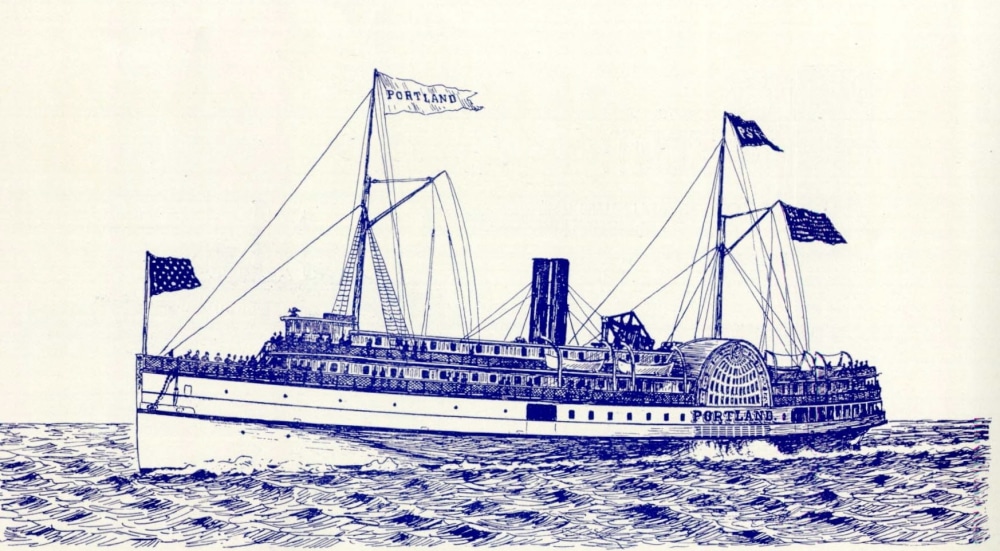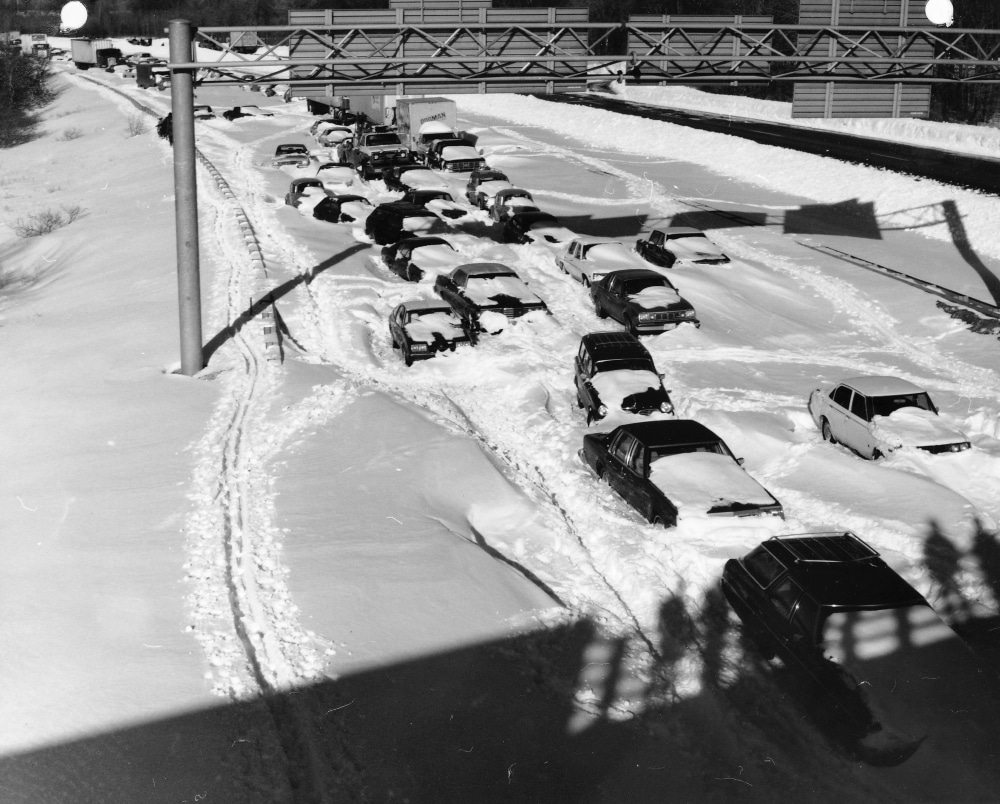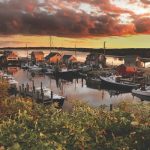History
The Worst New England Weather Disasters
Tornadoes, hurricanes, floods, blizzards — New England has had it all. Here are seven of the worst New England weather disasters in history.

Coffee By Design | Portland, Maine
Photo Credit : Katherine Keenan7 Worst New England Weather Disasters

Photo Credit : Samuel Ward Stanton
Gales of 1815 and 1898
The word hurricane wasn’t even in use yet, but the Providence Gale of 1815 would likely have been a category 3 storm by today’s standards. The first hurricane to strike New England in nearly two centuries, it caught the region thoroughly unprepared. Every state in the region was affected, with Rhode Island taking the hardest blow. The storm landed in Providence on September 23, destroying hundreds of homes and dozens of ships (several of which were lifted in the surge and bashed against downtown buildings). On November 26, 1898, the Portland Gale ended a quick trip up the East Coast by clobbering New England with the most powerful storm that had been recorded to date. More than 200 fatalities were attributed to the storm, and 150 boats were lost, including the S.S. Portland, which gave the storm its name. Coastal houses were blown down and washed away, and the coastline was littered with the wreckage of dozens of boats and ships.Heat Wave of 1911
The two-week heat wave in July 1911 killed nearly 2,000 New Englanders, making it the most devastating New England weather event of all time. Horses dropped in the street; young and old people overheated and expired. It was so hot that boats in Providence Harbor oozed pitch from their seams and began to take on water. Trains derailed because tracks had softened in the heat. At least 200 people drowned while attempting to cool off in rivers, lakes, and the ocean. See more: 6 Strange Weather Events in New England History | Worst Weather Disaster in New England History
Photo Credit : Keene Public Library and Historical Society of Cheshire County
Connecticut Flood of 1936
On March 11, 1936, a massive rainstorm fell on New England, where lakes and rivers were already brimming with melting snow. For two weeks, rain buffeted the eastern U.S. Some spots, including Pinkham Notch, New Hampshire, received nearly two feet of rain. The Androscoggin River in Maine rose to record levels, as did the Merrimack in Massachusetts and the Pemigewasset in New Hampshire. In Hartford, Connecticut River floodwaters rose 38 feet, a record that still stands. Dams burst and roads were washed away. It is estimated that 200 people were killed, and 14,000 were left homeless.
Photo Credit : NOAA, Steve Nicklas
Hurricane of 1938
In 1938, New England experienced a hurricane more powerful than any in the region’s recorded history. On September 21, as the storm crossed Long Island Sound and arrived in Connecticut, it was still intensifying. By the time it passed into Rhode Island, its winds were gusting to 120 mph. Fifteen-foot storm surges in Narragansett Bay left parts of downtown Providence under more than 13 feet of water. In Massachusetts, an astonishing wind gust of 186 mph was recorded in the Boston suburb of Milton. As it moved into northern New England, the storm began to dissipate. But by then, approximately 600 New Englanders were dead, with hundreds more injured. An incredible 4,500 homes were destroyed; another 25,000 or so were badly damaged. See more: Hurricane of 1938 Trivia | Remembering September 21 & 22, 1938Worcester Tornado of 1953
New England doesn’t see a lot of tornadoes, but in 1953 a twister a mile wide cut a swath of destruction through half a dozen towns in Western Massachusetts. It was easily the worst tornado in New England history. The big storm was on the ground for an hour and a half, destroying houses and tossing cars. In addition to the winds, hailstones the size of baseballs pelted Boston suburbs. Across New England, other tornadoes were touching down as well. More than 90 people died, more than 1,000 were injured, and some 4,000 buildings were destroyed.Hurricanes Connie and Diane, 1955
In the summer of 1955, a pair of hurricanes hit New England in quick succession. Hurricane Connie packed strong winds and heavy rain but had spent much of its energy by the time it arrived. As it turned out, Connie was just a little jab, momentarily distracting New Englanders from the haymaker that Hurricane Diane would deliver just days later. More than a foot of rain fell, causing massive flooding. Nearly 17 inches of rain fell on Torrington, Connecticut, and nearly 20 inches fell on Westfield, Massachusetts. Hundreds of dams and buildings were damaged, making Diane the most costly storm in U.S. history up to that point. An entire block of 13 houses washed away in Waterbury, Connecticut. More than 500 homes were lost in Connecticut, and 77 people were killed. See more: Worst Hurricanes in New England History
Photo Credit : Jim McDevitt/U.S. Army Corps of Engineers/Wikimedia Commons







There was no mention of Hurricane Carol in 1954. I was 9 years old at the time and terrified. It wiped out Gooseberry neck in Dartmouth and all of Horseneck Beach
Yankee published an issue with weather disaster articles sometime back in the 80s. I remember the article about the Hurricane of ’38 focussing on the effect of the storm on Westerly, RI and re-read it often, especially when we had tropical storms and hurricanes here in SC. I wish Yankee would re-publish those articles at least on the website. They were wonderful and I no longer have my copy of that issue.
I was a resident of Worcester when the 1953 tornado hit, but our house was not in its path. I think you article should be corrected to say that the tornado cut through half a dozen towns in Central Massachusetts, not Western Massachusetts. The confusion may be due to the fact that the western suburbs of Worcester were in the tornado’s path.
I lived on Lincoln St., Worcester, MA I was 8 years old. I was under the bed scared to death. The 1953 Tornado started in Petersham, MA and ended somewhere around Southboro, MA
I was activated with the National Guard both in the blizzard of 78 and the ice storm two weeks prior. We had to go in jeeps to try to get from East Greenwich to Providence all the while cleaning off windshields of cars to make sure that no one was still inside their vehicle or if they were deceased. It was a harrowing experience that I would not ever like to repeat.
I was ten years old and living in Torrington, CT, in 1955 during the flood. Our house was one house away from the Naugatuck River. During the night, dams in the surrounding hills burst and water raged down the river, overflowing it. Buildings, automobiles, trees, and livestock from farms were carried downriver by the rapid flow, crashing into homes in my neighborhood. My dad dug the metal posts from our clothes line outside and propped them up inside the house against the walls to keep them from collapsing in. We were unable to leave because the flooding from the burst dams happened so quickly and the water was flowing so fast. All night long we heard and felt things crashing into the house and prayed that the house would hold. Thank God it did. We were lucky; we lived on the second floor of our apartment house. The water came within 12 inches of our floor but the family on the first floor lost everything. There was a foot of mud in their home after the water receded. My father’s aunt, who lived just behind out house, drowned. The National Guard was trying to rescue her by lowering her by rope from her second-floor porch when the rope snapped and she was washed away. Her body was found a week later. Little can compare to the horror and fear of that night. Then in the weeks after there was no electricity or water. The Red Cross and Salvation Army brought in big tanker trucks with water for people to go and fill up whatever containers they had. The Red Cross was charging for their water. The Salvation Army was not.
I was walking to my dentist appointment in downtown Brockton, Massachusetts in ’54. Across the street I saw a large sign blow down and I remember thinking
BOY ! IT’S WINDY TODAY.
Minutes later a large mailbox went tumbling down the middle of Main Street. I remember thinking at that time
I’VE NEVER SEEN IT THIS WINDY
When I finally got to Dr Chase’s office I found that he had prudently stayed home. I hitched a ride home and remember seeing downed signs, trees, and power lines on the ride home. When I got home I saw that the very large pig nut tree in my front yard had been snapped like a twig.
My mother told me we had just been visited by a hurricane. I remember that later in the week I was often told by older people
THAT HURRICANE WAS NOTHING. YOU SHOULD HAVE SEEN THE HURRICANE OF ’38.
That would have been difficult because it occurred 2.5 years before I was born.
I thought the hurricanes of 1955 were Carol and Edna. The first was Carol and Edna came shortly after her. I lived in R.I. and was in the 4th grade, at this time.